The Arctic Liquid Freezer III 280 A-RGB White AIO Review: Refined Design Brings Stand-Out Cooler
by E. Fylladitakis on March 13, 2024 9:00 AM EST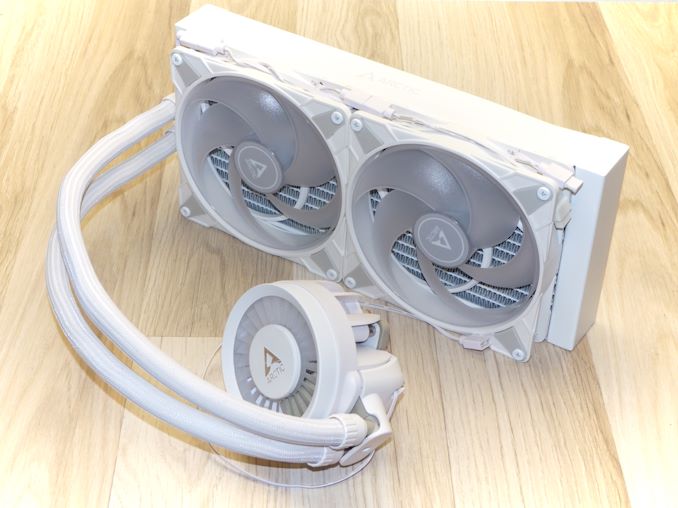
ARCTIC GmbH, originally known as Arctic Cooling, first burst onto the PC cooling scene in 2001 and has since maintained its stature as a leader in cooling technologies. The company made its mark with top-notch thermal compounds and has since kept its focus on cooling solutions while also expanding into other tech accessories, including advanced monitor mounts and audio products.
With the introduction of the Liquid Freezer III series, ARCTIC has taken another significant step forward in the cooling market. This new lineup builds upon the success of the previous Liquid Freezer II series, the great price-to-performance ratio of which made it a highly popular product. Today, we're delving into ARCTIC's latest offerings with the Liquid Freezer III series and, specifically, the 280 A-RGB White model. We'll assess the features, quality, and thermal performance of the AIO (All-In-One) cooler of the series ARCTIC is hoping to dominate the bulk of the mainstream market with.
| ARCTIC Liquid Freezer III 280 mm A-RGB White AIO CPU (ACFRE00151A) Cooler Specifications |
|||
| Type | All-in-One Liquid Cooler | ||
| Dimensions | 317 x 138 x 63 mm (radiator with fan) 42 x 42 mm (coldplate) |
||
| Fans | 2 x 140 mm P14 PST FDB Bearing Fans 1900 RPM (max) |
||
| RGB | Yes (ARGB) | ||
| Supported Sockets | Intel: LGA1700 / LGA1851 AMD: AM5 / AM4 |
||
| Warranty | 6 Years | ||
| Price | $99 (under promo) | ||
Packaging & Bundle
We received the Liquid Freezer III in a typical cardboard box, with custom inserts protecting the cooler during shipping. The artwork on the box is very clean and sophisticated, with a white/black schematic theme. Basic information regarding the cooler and its features can be found on the sides and rear of the box, however, there is a QR code that leads to a very comprehensive digital manual.
ARCTIC kept the bundle as frugal as possible, but they included all of the essentials. Aside from the basic hardware required to mount the cooler, the company provides a unique contact frame for socket LGA1700/LGA1851 processors, a small syringe of MX-6 premium thermal compound that should be enough for a couple of installations, and two different power connectors. One of the connectors allows the precise control of the pump, VRM fan, and radiator fan when connected to three separate motherboard headers, while the other one connects to a single header and all three mechanisms share the same PWM signal. There is no installation leaflet or manual supplied, users will have to find those online. ARCTIC also does not include a LED driver, meaning that the LEDs cannot be used if the motherboard does not have a header for A-RGB LEDs or a third-party controller is present. Note that the Liquid Freezer III is compatible with only socket LGA1700, LGA1851, AM4, and AM5 processors. ARCTIC has ditched compatibility with older sockets, presumably in favor of a slightly lower retail price.
The ARCTIC Liquid Freezer III 280 A-RGB White AIO Cooler
The Liquid Freezer III series is available in four sizes (240-, 360-, 280-, and 420-mm radiators), with each size available in three colors (Black with no LEDs, Black with A-RGB LEDs, and White with A-RGB LEDs). ARCTIC supplied us with the A-RGB White version of the Liquid Freezer III 280 mm cooler for this review.
At first glance, the Liquid Freezer III 280 mm cooler bears a resemblance to most other AIO coolers available, with a standard configuration of a single radiator, two hoses, and a main block that combines the CPU contact plate and the liquid pump. However, the major differences between it and the bulk of the available coolers quickly become apparent. First and foremost, everything about the cooler is white and there are virtually no loose cables, making the design exceptionally neat and visually appealing. ARCTIC’s engineers passed the fan wires from the inside of the tubing’s sleeving, a clever tactic that we first encountered on our recent look on Corsair’s iCUE LINK H150i RGB AIO cooler. The difference here is that, unlike Corsair, ARCTIC kept the standard power and LED connectors, which does make the fan cables visible around their frame, but also allows the users to replace these fans with anything available in the market should they wish to.
The radiator is perhaps the highlight of the Liquid Freezer III coolers, with ARCTIC opting for a 38 mm thick radiator. This could be the source of compatibility woes, especially with older and/or smaller cases, as the completed cooler requires a clearance of at least 65 mm to be installed, but also increases the heat exchange surface area greatly.
In terms of design, the radiator adheres to the standard dual pass cross-flow configuration, featuring tiny fins soldered onto thin oblong tubes, a common design trait shared by the majority of AIO cooler radiators. A very close look at the fins reveals that they are serrated, a tactic that sacrifices heat exchange area in favor of airflow dynamics and typically works well with larger radiators. Regardless of the serrated fins, ARCTIC is employing their P-series fans, which are high pressure designs that employ very few and wide blades. The company logo is subtly etched across the sides of the radiator.
The main block assembly of the Liquid Freezer III coolers is significantly different than that of most other designs. It is significantly larger than most and not because of an oversized pump or large contact area, but because it includes a small fan for cooling the VRM heatsinks around the CPU socket. Note that the fan is not the tiny blades seen at the top of the block - these are ornamental only - but a narrow and tall plastic impeller hidden underneath it.
The top half of the block that hosts the VRM fan and the RGB LEDs is magnetically attached and can be removed effortlessly by simply pulling it off. This reveals the basic electronics of the block, allowing the insertion of the power cable to the right. Note that the power cable needs to be routed from underneath the plastic cover, from where the LED cable exits the block as well, otherwise the top cover will not fit. We can see that almost the entirety of the block, with the sole exception being the copper contact plate and metallic retention parts, is made of plastic. This includes even the fittings of the coolant hoses.
A very small copper contact plate can be found at the bottom of the cooler, held in place with four screws. The surface of the plate is very well polished and perfectly flat, ensuring great contact with the processor’s shim. The contact area is very small, barely over 40 by 40 mm.
The RGB lighting application on the Liquid Freezer III is good. LEDs are installed in the hubs of the fans, lighting their opaque blades. ARCTIC is using the same opaque material for the faux blades at the top of the CPU block cover, trying to mimic the same lighting effect. The issue here is that the faux blades, unlike the real blades of the fans, do not spin when the cooler is powered. The final outcome is not the best that could be but is aesthetically pleasing.


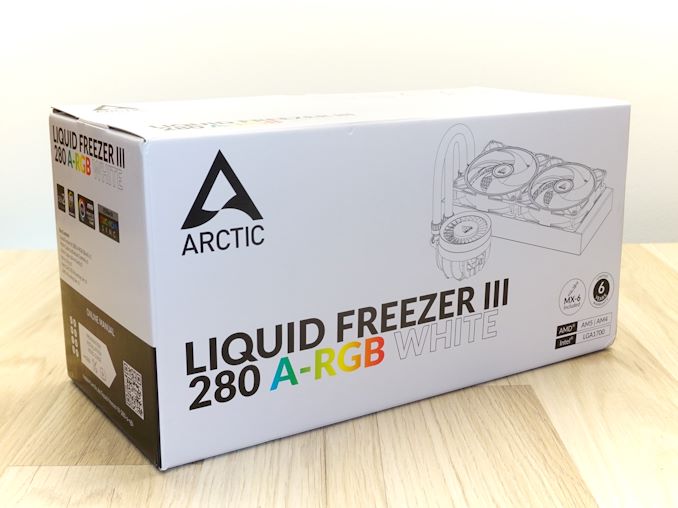
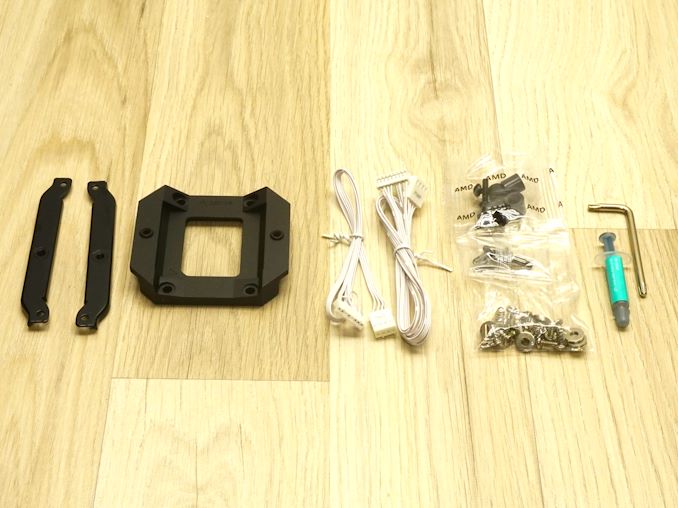

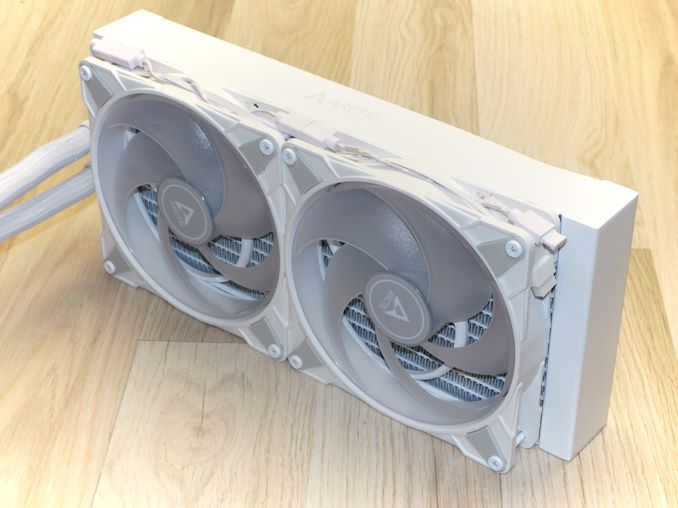
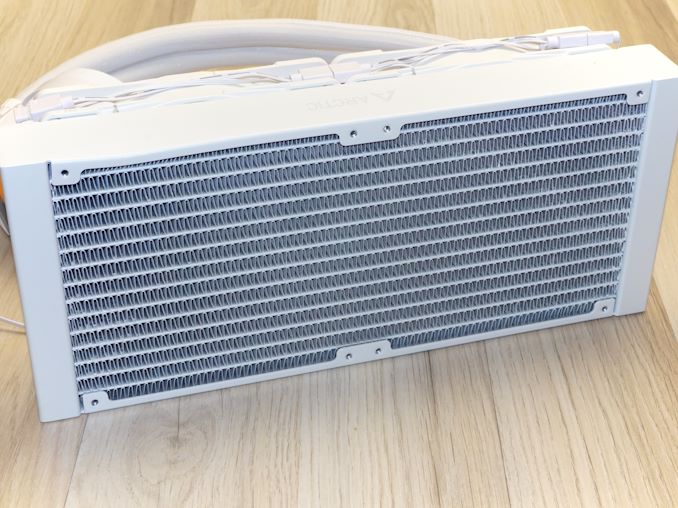
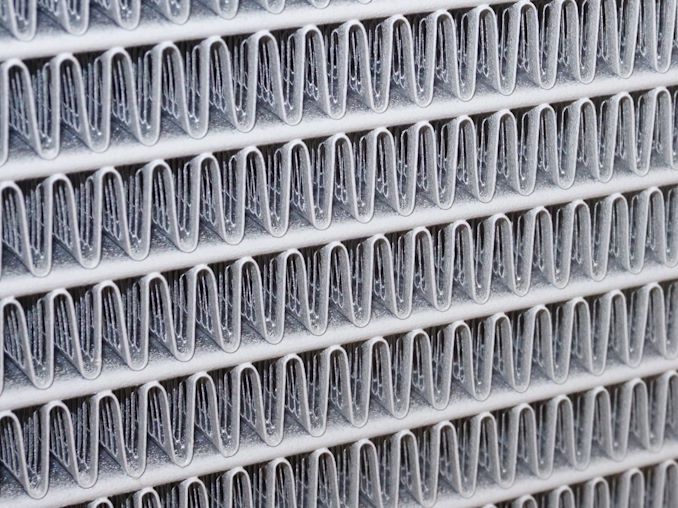
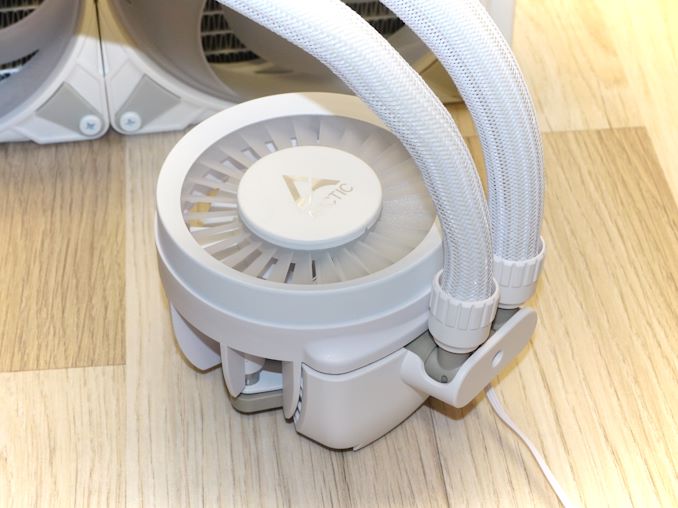
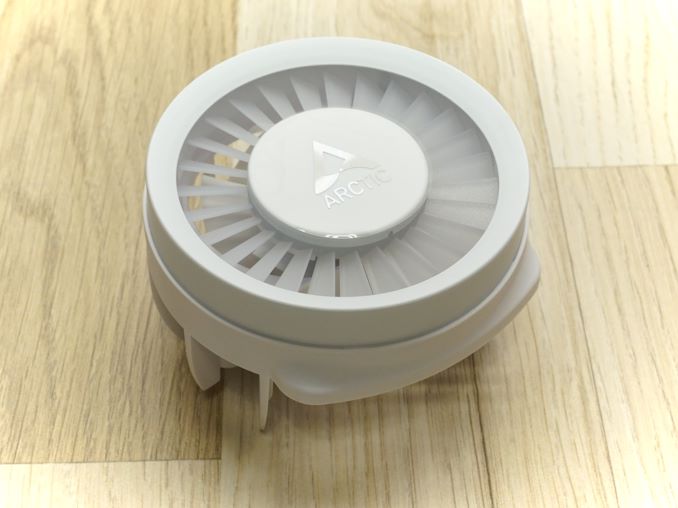

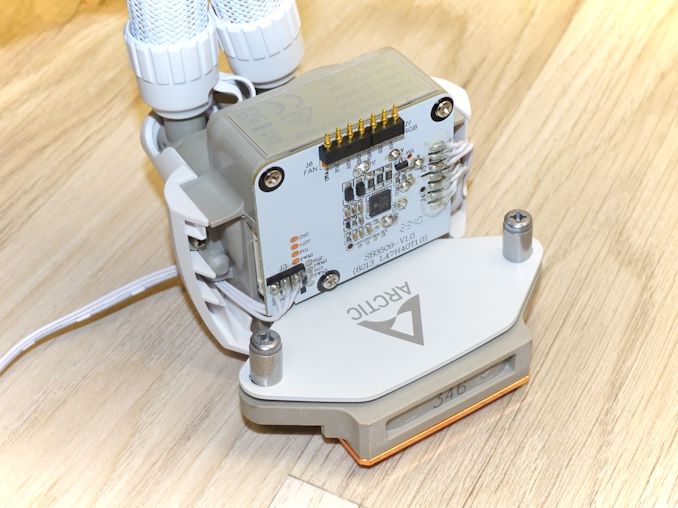
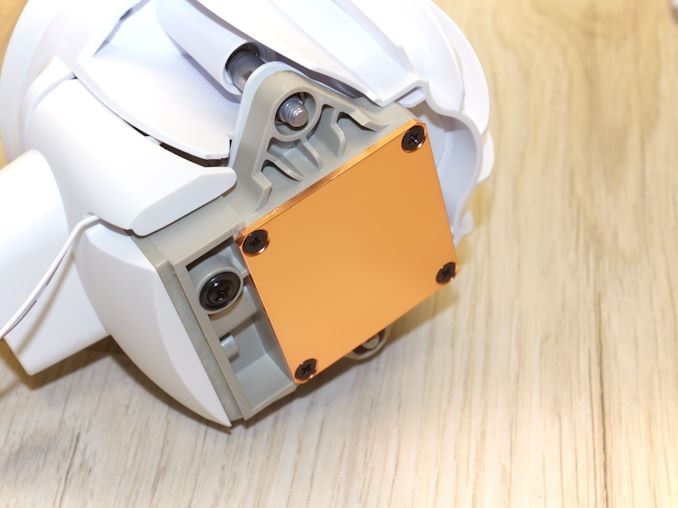
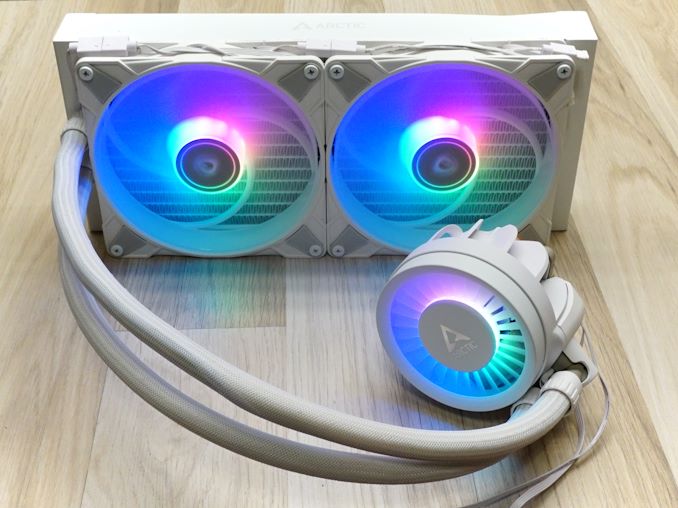
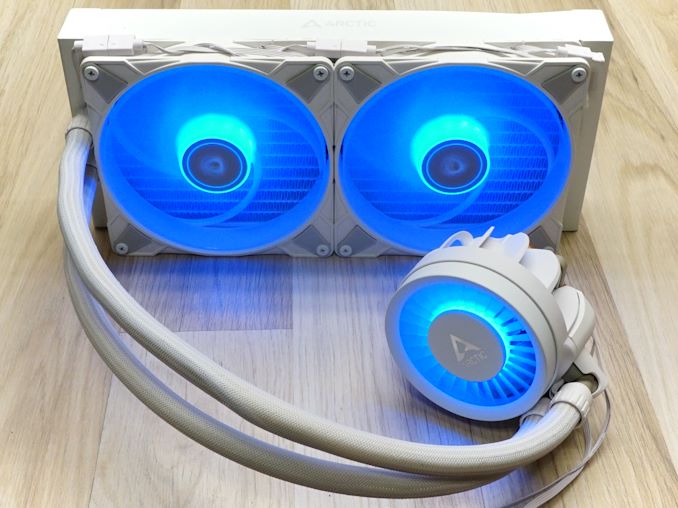
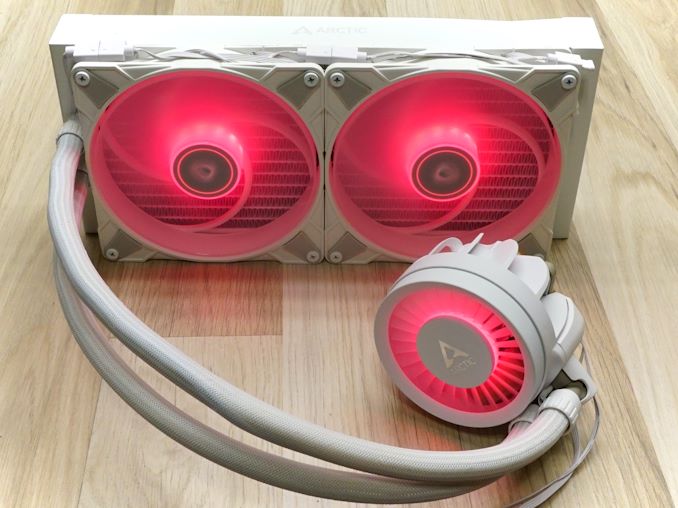








8 Comments
View All Comments
Maksdampf - Wednesday, March 13, 2024 - link
Coldplate size (thats the technical term, not „contact plate“) being too little is not a reason for the bad performance. What matters is not the size of the copper chunk, but its active area. The active finned area must be the same size or larger then the DIE underneath the IHS. But the fin area and water channels are similarly sized as the competitors.More likely your decades old testing Station has a far thicker baseplate or DIE size compared to a real CPU, so the measurements are not realistic. Time to make a new DIE simulator.
But i assume there is something else wrong too.
The baseplate in the Liquid freezer II is the same, but it is performing better, so this test result must be worse due to a bent IHS or a fault with the mounting hardware.
Since every other media outlet so far has seen improvements compared to the LF II series, i would not have published these results without further research into the issue.
E.Fyll - Wednesday, March 13, 2024 - link
The descriptive term "CPU contact plate" is very frequently used by professionals and amateurs alike. True, the correct technical term for liquid coolers is "cold plate" but I personally choose to use casual language and descriptive terms when appropriate, as I don't expect every single reader to be familiar with the technical terminology.The mass and size of the cold plate do matter in several ways. The "active" area does matter but it is not the only thing that does. It actually doesn't even matter the most - the shape is what matters the most as it affects both the movement of the liquid (boundary layer fluid mechanics) and the transfer of energy between the mediums. If the liquid contact area of the cold plate was all that mattered for performance, it would be shaped in the form of a small rectangular finned corridor for the fluid to flow through, similar to how finned radiators are shaped, multiplying the liquid contact area compared to current designs. Still, that design doesn't work quite well despite the much greater liquid contact area, for a number of reasons.
The testing station does not fully replicate a specific CPU's die, which is a very high thermal load concentrated in a very small area, but spreads the thermal energy almost evenly across the entire contact plate, replicating an ideal 40x40 IHS. It is perfectly valid for measuring the thermal resistance of coolers without relying on case-specific parameters. If I were to make the faux die that is the exact shape and die of any processor, the test results would be completely incomparable not only between generations of processors but between different sockets as well.
I have learned not to take too much heed to other people's test results as I frequently cannot match mine with those no matter how hard I try. I did double-check this review's test results because I found them very strange myself, which is why the review was late (again). Yes, the cold plate may be similar/identical but not the entirety of the cooler is. There are myriads of factors that affect performance, down to the very paint on the radiator.
For those that are a bit distrustful, or even cynical, one should also consider that I could very well be "cooking" the results to whatever I want and avoid confrontations such as this one but, as you can tell, I choose to go with the actual readings and deal with the fallout instead.
Maksdampf - Thursday, March 14, 2024 - link
Yeah, i get it, turbulent flow for boundary layer separation is important too. I wasn't saying that the internals don't matter, and you weren't saying anything about internals in your article either. I was just saying that you can't judge a book by its cover or a waterblock by its coldplate size.The mass of the coldplate is really not that important. A heavier and thus thicker coldplate performs worse in most cases because even pure copper would be an insulator between the flowing water and CPU, adding thermal resistance. Also when talking about thermal mass, you mean thermal capacity most likely. Thermal capacity of copper is almost negligible compared to water. So if you wan't mass simply for thermal inertia in a waterblock it is much better to have water there instead of copper soaking up the heat. So less copper performs better in many cases.
I understand that the somewhat bad results of this CLLC are most likely down to the test platform specifics and not your thorough measuring process. But still, how valuable are they then?
If you knew this and even doublechecked the results, how could you not write something about this discrepancy and its most likely cause in your review? Instead you make something up with coldplate size, which doesn't matter on a real CPU and only the very thermodynamics literate and curious people can summize that the Testing setup may be the reason here why this CLC performs so bad an others so well.
I get it that you don't wan't to throw away 20 years of comparability between coolers by still using the same platform. But then i don't undertsnd why you are not using any of the Data. Why is the graph not a javascript generated one where i can select my comparision with a drop down menu?
I also don't get these 12V and 7V measurements instead of noise normalized bar charts which are much easier to undertand for a consumer. 20 years ago people limited their fanspeed by connecting it to the +12V and +5V DC from the PSU directly, but nowadays in the Age of PWM nobody cares.
All other outlets have switched to noise normalized values, which you could be doing too, since you have the data vor a curve. But you chose not to.
I myself was developing waterblocks 20 years ago and hat a very similar test platform using a microcontroller and a fet heater. I used a Athlon64 IHS with a small 15x15mm copper block soldered onto the middle where the fet was screwed onto and a probe was drilled inserted in a small drilled hole on the side to measure exactly central to the die.
Even this had slightly different results to real CPUs. I have stopped doing that back then since i could not be true to my aspirations.
These Tests are not good for anybody looking for an AIO or Aircooler today. Things like offset mounting for AMD or contact frame play a huge role and you just ignored that.
osv - Friday, March 15, 2024 - link
re: your misplaced claims, for instance, "These Tests are not good for anybody looking for an AIO or Aircooler today"what i see is that you didn't actually read the review, and therefore your comments are not helpful, and your criticisms are not valid.
for example, your claim: "nowadays in the Age of PWM nobody cares"... umm no, as the article repeatedly pointed out, the speeds of the pump vs. cooler fans vs. vrm fans can't be controlled individually, which is a drawback for tuners who want those options, and had it years ago... i appreciate that the author made that point wrt price, while you apparently don't understand what matters to people reading these articles.
i appreciate that the data posted backs up his conclusion that "This places ARCTIC’s latest 280 mm cooler in direct competition with 360 mm AIO coolers and even close to the 420 mm version of the Liquid Freezer II, which used to perform a little better but at a much higher noise level."
you claimed: "the Testing setup may be the reason here why this CLC performs so bad"... except that it didn't test badly, it was quieter than the competition, which is a high priority for many readers, and the author got that; you didn't.
Lolshutupbro - Tuesday, March 19, 2024 - link
The pump speed, fan and vrm fan can be controlled individually, there is a cable included….m3city - Thursday, March 14, 2024 - link
I asked this before, but never got a response, and asking google does not really give an answer as well: why is there no comparison to an air cooler? A stock one would be the best, but any would be great. I still don't know what will I gain in terms of loudness, temps, OC/boost headroom?PeachNCream - Thursday, March 14, 2024 - link
Here ya gohttps://gamersnexus.net/megacharts/cpu-coolers
m3city - Friday, March 15, 2024 - link
Thank you very much! That is exactly what I was looking for.